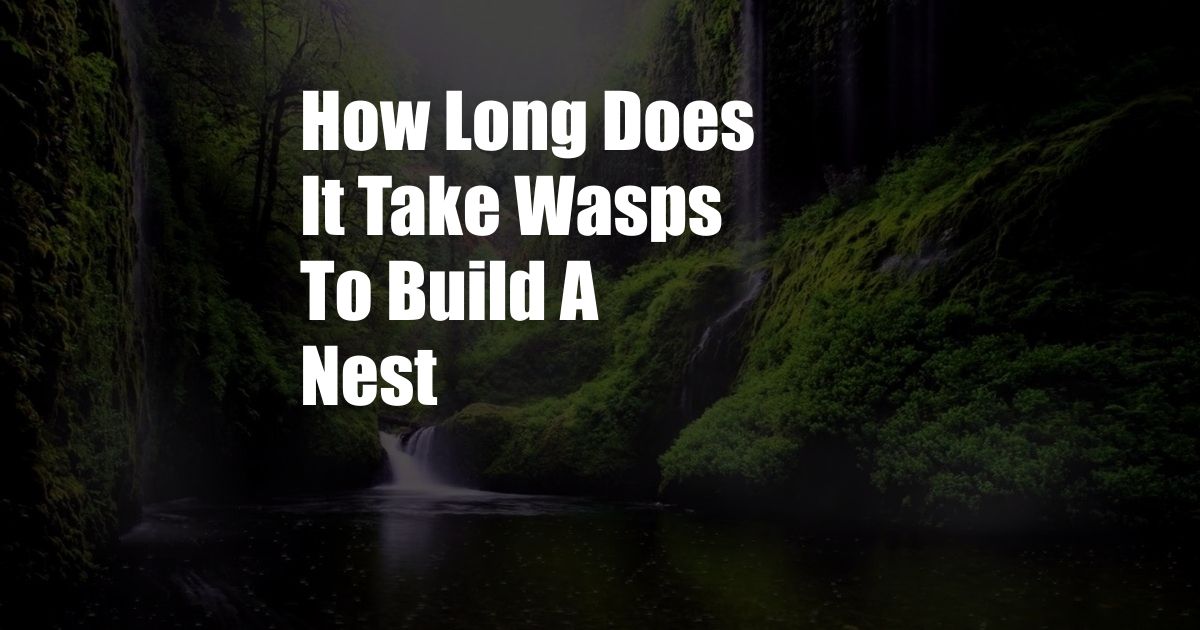
How Long Does It Take Wasps to Build a Nest?
In the depths of summer, as the sun beats down relentlessly, many of us find ourselves sharing our outdoor spaces with unwelcome guests: wasps. These buzzing pests are known for their painful stings and aggressive behavior, making their presence a nuisance. But how long does it take for these insects to construct their papery nests that house their colonies? Understanding the timeline of wasp nest-building can help us take proactive measures to prevent infestations.
Once a queen wasp emerges from hibernation in the spring, she sets out to establish a new colony. Her first task is to find a suitable location for her nest. Wasps prefer to build their nests in sheltered areas, such as under eaves, in trees, or in abandoned burrows. Once she has selected a spot, the queen will begin to collect materials to build her nest.
The Construction Process
Wasp nests are made of a paper-like material that is produced by the wasps themselves. They use their saliva to mix wood fibers and other plant materials into a pulp, which they then shape into hexagonal cells. The cells are used to store food and to raise the wasp larvae. The nest is built in stages, with the queen wasp adding new cells as the colony grows.
The size of a wasp nest can vary depending on the species of wasp and the size of the colony. Small nests may only contain a few hundred cells, while large nests can contain thousands of cells. The queen wasp will lay eggs in the cells, and the larvae will hatch and develop into adult wasps. The entire process of nest construction can take anywhere from a few weeks to several months, depending on the size of the nest and the weather conditions.
Factors Affecting Nest-Building Time
- Species of wasp: Different species of wasps have different nesting habits. Some species, such as yellow jackets, build their nests above ground, while others, such as paper wasps, build their nests in cavities.
- Size of the colony: The size of the colony will also affect the time it takes to build a nest. A large colony will require a larger nest, which will take longer to build.
- Weather conditions: The weather can also affect the time it takes to build a nest. Wasps are less likely to build their nests in cold or rainy weather.
Tips for Preventing Wasp Nests
The best way to prevent wasp nests is to eliminate potential nesting sites. This means keeping your yard clean and free of debris. You should also seal up any holes or cracks in your home that could provide wasps with access to the inside. If you do find a wasp nest on your property, it is important to remove it as soon as possible. You can do this yourself using a commercial wasp spray or by calling a professional pest control company.
Expert Advice
Here are some additional tips from experts on how to prevent wasp nests:
- Avoid using bright colors: Wasps are attracted to bright colors, so avoid wearing bright clothing or using bright decorations around your home.
- Keep food and drinks covered: Wasps are also attracted to food and drinks, so be sure to keep them covered when you are outdoors.
- Be aware of your surroundings: When you are outdoors, be aware of your surroundings and watch for wasps. If you see a wasp, do not swat at it or try to kill it. Simply move away slowly.
FAQ
Q: How long does it take for wasps to build a nest?
A: The time it takes for wasps to build a nest can vary depending on the species of wasp and the size of the colony. Small nests may only take a few weeks to build, while large nests can take several months.
Q: What are wasp nests made of?
A: Wasp nests are made of a paper-like material that is produced by the wasps themselves. They use their saliva to mix wood fibers and other plant materials into a pulp, which they then shape into hexagonal cells.
Q: Where do wasps build their nests?
A: Wasps prefer to build their nests in sheltered areas, such as under eaves, in trees, or in abandoned burrows.
Q: How can I prevent wasp nests?
A: The best way to prevent wasp nests is to eliminate potential nesting sites. This means keeping your yard clean and free of debris. You should also seal up any holes or cracks in your home that could provide wasps with access to the inside.
Conclusion
Wasp nests can be a nuisance, but understanding the timeline of their construction can help us take proactive measures to prevent infestations. By eliminating potential nesting sites and following the tips outlined above, we can reduce the risk of wasps building nests on our property. If you do find a wasp nest, it is important to remove it as soon as possible to avoid being stung. By taking these simple steps, we can enjoy our outdoor spaces without having to worry about wasps.
Are you interested in learning more about wasps and their nesting habits? Leave a comment below and let me know what you would like to know!